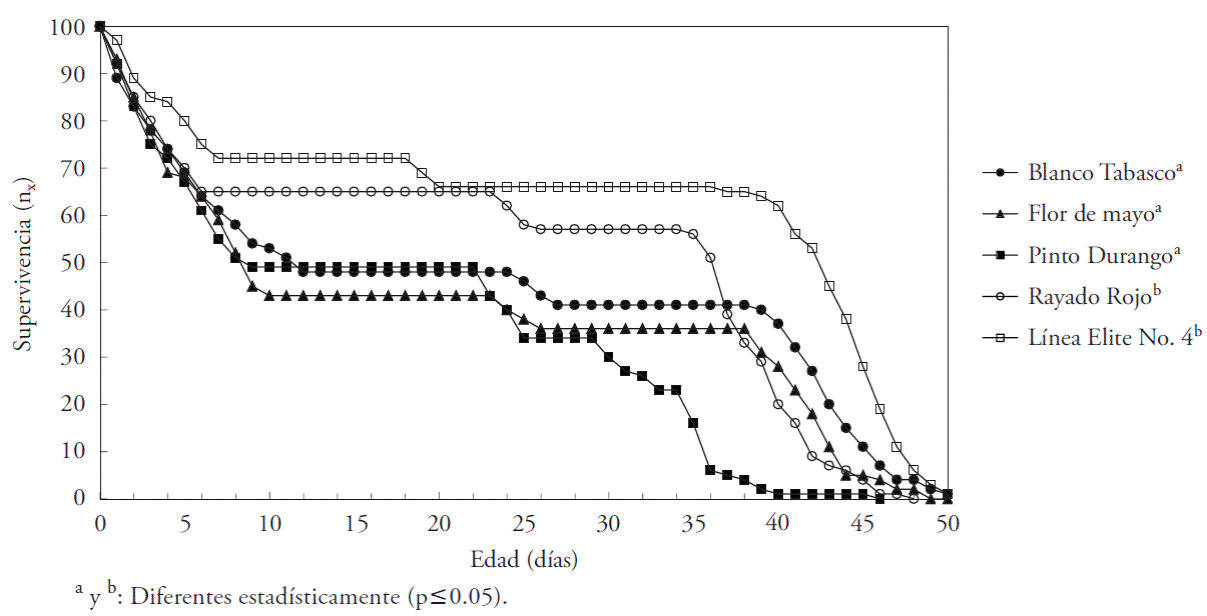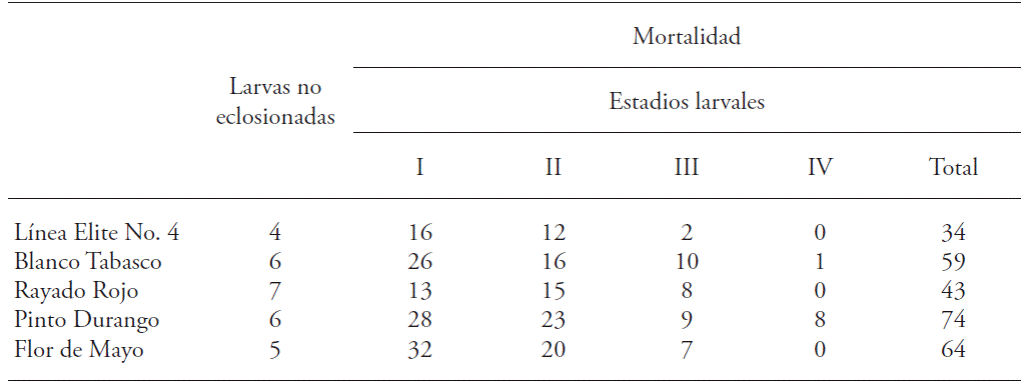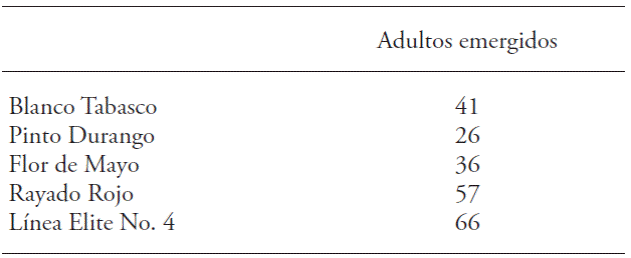Servicios Personalizados
Revista
Articulo
Indicadores
-
 Citado por SciELO
Citado por SciELO -
 Accesos
Accesos
Links relacionados
-
 Similares en
SciELO
Similares en
SciELO
Compartir
Agrociencia
versión On-line ISSN 2521-9766versión impresa ISSN 1405-3195
Agrociencia vol.50 no.3 Texcoco abr./may. 2016
Crop science
Insect population parameters of Acanthoscelides obtectus (Say.) in grains of five cultivars of common bean (Phaseolus vulgaris L.)
1Programa Académico de Entomología y Acarología, Campus Montecillo. Colegio de Postgraduados. 56230. Montecillo, Estado de México.
2Programa de Mejoramiento Genético. Campus Montecillo. Colegio de Postgraduados. 56230. Montecillo, Estado de México.
Acanthoscelides obtectus (Coleóptera, Bruchidae) is a phytophagous insect that feeds on beans (Phaseolus vulgaris L.) during storage, principally in temperate climate regions. For this reason, it is necessary to determine population parameters of this coleopteran that would permit prognosis of populations and identification of resistant beans. Population parameters were estimated with the cohort life table technique, the Logrank test (p ≤ 0.05) and reproductive rates, and confidence intervals with the non-parametric technique Overlapping Intervals (p≤0.09) to compare instantaneous rate of population growth (rm), also called innate increment capacity. These parameters were estimated in the bean cultivars Blanco Tabasco, Flor de Mayo, Pinto Durango, Rayado Rojo and Línea Elite No. 4, all resistant to two types of rust caused by Uromyces phaseoli var. typica and U. appendiculatus. Weevil population parameters were higher for adult emergence, mean life expectancy and reproductive rates in the cultivars Rayado Rojo and Línea Elite No. 4.
Key words: Acanthoscelidts obteđus; grain borers; Phaseolus vulgaris; survival; reproduction
Acanthoscelides obtectus (Coleoptera, Bruchidae) es un insecto fitófago que consume granos de frijol (Phaseolus vulgaris L.) en condiciones de almacenamiento, principalmente en regiones de clima templado, por lo que es necesario conocer los parámetros poblacionales de este coleóptero que permitan pronosticar poblaciones e identificar frijoles resistentes. Los parámetros poblacionales se estimaron con la técnica de tablas de vida de cohorte, la prueba Logrank (p≤0.05) y las tasas de reproducción e intervalos de confianza con la técnica no paramétrica de Traslape de Intervalos (p≤0.09), para comparar tasas instantáneas de reproducción (rm), llamada también capacidad innata de incremento. Estos parámetros se estimaron en los cultivares Blanco Tabasco, Flor de Mayo, Pinto Durango, Rayado Rojo y Línea Elite No. 4, todos resistentes a dos tipos de roya ocasionada por Uromyces phaseoli var. typica y U. appendiculatus. Los parámetros poblacionales fueron mayores en la emergencia de los adultos, esperanza media de vida y tasas de reproducción del gorgojo en Rayado Rojo y Línea Elite No. 4.
Palabras clave: Acanthoscelides obtectus; barrenadores de granos; Phaseolus vulgaris; supervivencia; reproducción
Introduction
Insects and diseases in the field and in storage deplete bean (Phaseolus vulgaris L.) production, reducing not only yield but also grain quality of this legume. In the 1980s, the Centro Internacional de Agricultura Tropical (CIAT, 1988) pointed out that the Mexican bean weevil (Zabrotes subfasciatus Boh.) and the common bean weevil (Acanthoscelides obtectus Say; Ordet Coleóptera, family Bruchidae) are the most important pests of beans. Specifically the latter insect is catalogued as the primary pest because of the damage it causes to stored grains (Vera et al., 2011).
It is widely distributed throughout the high valleys of Mexico, but it has also been detected in tropical regions. Damage severity and population parameters of A. obtectus vary largely depending on the bean cultivar, testa hardness and the naturally occurring antibiotics in the colyledons (Ramirez et al., 2003).
The Bean Breeding Program of the Colegio de Postgraduados and the Department of Plant Science of the Universidad Autónoma Chapingo selected five bean cultivars resistant to rust (Uromyces phaseoli var. typka or U. appendiculatus). Their general characteristics are the following:
1) Blanco Tabasco (CHA-2012): cultivated in humid tropical regions, growth habit I (bushtype), 98 d to maturity, mean yield 975 kg ha -1, and susceptible to virus.
2) Fior de Mayo (5C-2020-CHA-2012): cultivated in the west-central region, growth habit II (bush-type with a short vine) and mean yield of 1348 kg ha-1.
3) Pinto Durango (CHA-2012): grown on the semi-arid high plateau (Durango and Zacatecas), growth habit II (bush-type with short vine), 110 d to maturity and mean yield of 1325 kg ha -1.
4) Rayado Rojo (CHA-2012): grown in the tropics of Chiapas and Veracruz, growth habit I (bush-type), 98 d to maturity, and mean yield is 985 kg ha -1.
5) Linea Elite No. 4 (CHA-2012): cultivated in the high valleys of the central plateau, growth habit II (bush-type with short vine), 115 d to maturity and mean yield 1225 kg ha -1.
The objectives of this study were to estimate and compare the population parameters of A. obtectus in these bean cultivars to detect the cultivars most resistant to weevil infestation.
Materials and Methods
The study was conducted in the insect ecology laboratory of the graduate program in Plant Health of the Colegio de Postgrraduados, Campus Montecillo, in 2014. One rearing chamber was used with controlled environment (28±2 °С, relative humidity 70±3% and continuous illumination).
The bruchid population was incremented to obtain sufficient insect specimens, following Vera et al. (1997). In addition, the grains of each genotype were washed, dried and kept in paper bags at 4 °С for three months to prevent damage by insects, mites or pathogens. Initial moisture of the grains was 7 and 8 % measured with an automatic moisture meter (Stein lite™).
Population parameters were estimated with the technique of life and fertility tables, mainly with the Logrank test (p≤0.05) (Méndez et al, 1984). In this way, weevil survival (nx), larva mortality, mean life expectancy (ex), adult emergence, net reproductive rate (R0) (p≤0.05), intrinsic rates of population growth (rm) (p≤0.01) and average generation time (Т) curves were obtained (Krebs, 1985).
The bruchid's life tables were constructed with eggs obtained from the mentioned offspring. To stimulate oviposition, 300 adults were placed in a glass Petri dish (9 cm in diameter) with CV Peruano beans, and 24 h later the eggs were separated to have the certainty that they had been laid on the same day and that the proportion of females to males was approximately 1:1. For each bean cultivar, an initial cohort was established with 100 eggs taken at random. The eggs were placed in glass Petri dishes (9 cm in diameter), and 100 beans of each cultivar were placed in each dish. In this way, intraspecific competition for food was avoided because of the grain:egg ratio of 1:1. The bean grains were agglomerated in the Petri dishes so that, once the larvae hatched, they would have support from adjacent grains to penetrate other grains. The Petri dishes were handled carefully to prevent inhibiting the larvae from penetrating (Quentin et al, 1991).
The number of newly hatched larvae was recorded daily, as well as number of first stage larvae that did not penetrate the testa of the grains. For a count of larvae that died inside the grains and determine the stage in which they died, 30 to 31 d after initiating the cohorts, when adults emerged from the grains, the non-perforated (apparently healthy) grains were cooked and dissected to find the dead larvae. Their development stage was estimated by their size and shape (El-Achkar et al., 1991).
Survival curves were constructed with data from the life tables and compared with the Logrank test. The death frequencies of each population were used to assess the discrepancies between these frequencies (o) and the expectation (E) of their occurrence when the null hypothesis is true. These discrepancies are measured with χ 2 cal, which is compared with χ 2 0 . 05 (2 d.f.) (Méndez et al, 1984). With these data, the mean life expectancy of the insects in each cultivar was estimated.
Fertility tables were constructed with data of the weevils that reached adulthood (males and females). The adult weevils were placed in Petri dishes (9 cm radius) that contained bean grains of the same genotype from which they had originated and the number of eggs laid was recorded daily. With these data the net reproductive rate (Ro), intrinsic rate of population growth (rm) and mean generation time (Τ) were estimated, following the methodology described by Sánchez et al. (1997) and Vera et al. (2002). The five rates of population growth (rm) were compared with the Vera and Sotres (1991) Overlapping Interval test (p≤0.09).
Results and Discussion
The A. obtectus life tables in each bean genotype are presented as survival curves (Figure 1). The Logrank test did not detect significant differences (p>0.05) between bruchid cohorts in the cultivars Blanco Tabasco, Flor de Mayo and Pinto Durango. There were, however, differences between these three cultivars and the Rayado Rojo and Línea Elite No. 4 cultivars. This was due to the fact that insect mortality was higher inside the grains of the first three cultivars (Table 1) than in Rayado Rojo and Línea Elite No. 4.

Figure 1 Survival curve of Acanthoscelides obtectus (Say) reared in five bean (Phaseolus vulgaris L.) cultivars.
Table 1 Mortality of Acanthoscelides obtectus larvae reared in five bean (Phaseolus vulgaris L.) cultivars.

In Blanco Tabasco, Pinto Durango and Flor de Mayo, the number of emerged adults (30 to 31 d old) was lower than in Rayado Rojo and Línea Elite No. 4 (Table 2).
Table 2 Emerged Acanthoscelides obtectus adults reared in five bean (Phaseolus vulgaris L.) cultivars.

Mean insect life expectancy (ex), in general, was also longer in the last two genotypes (Table 3)·
Table 3 Mean life expectancy (ex) of Acanthoscelides obtectus reared in five bean (Phaseolus vulgaris L.) cultivars.

†Values recorded every 10 days.
The above was reflected in the weevil's reproductive rate, R0 and rm (Table 4); thus, the rates of Blanco Tabasco, Flor de Mayo and Pinto Durango were the lowest. The Overlapping Intervals test did not detect significant differences (p>0.09) among Pinto Durango, Flor de Mayo and Blanco Tabasco, nor between Rayado Rojo and Línea Elite No. 4.
Table 4 Reproductive rates (R0 and rm) and generation time (T) of Acanthoscelides obtectus reared in bean (Phaseolus vulgaris l.) cultivars.

a,bStatistically different (p≤0.09). rm (individual d-1).
A higher reproductive rate does not mean longer generation times (T) (Vera et al., 2012). Generation is understood as the period between birth of parents and birth of offspring.
Blanco Tabasco was the most damaged cultivar; the reproductive rate rm (which is expressed as individual d-1) was lower in a longer Т The opposite occurred with Rayado Rojo and Línea Elite No. 4, whose generation times were close to those of Blanco Tabasco. Consequently, it would be recommendable to cross initially Blanco Tabasco, Flor de Mayo and Pinto Durango with cultivars known for resistance to the insect (with rm≤0.02), such as Colorado landrace beans and black beans from Chiapas and Tabasco (Bolaños and Vera, 1997). With this, resistant beans can be successfully produced in a short time.
Regarding adult emergence and reproductive rate, it should be pointed out that the populations with high numbers of emerged adults may not have higher reproductive rates (Ramirez et al., 2003). This is observed more often in landrace beans (Vera et al., 1998), whose reproductive capacity (rm) is equal to or lower than 0.02.
No relationship between growing region, resistance to rust and growth habit of the beans was identified with the Overlapping Intervals test. This means that in storage A. obtectus can parasite (with higher or lower intensity) any of the studied cultivars.
Conclusions
No statistically significant differences were detected in the survival curves of A. obtectus Say in Blanco Tabasco, Flor de Mayo, Pinto Durango, Rayado Rojo and Línea Elite No. 4, but there were differences between the first three and the second two cultivars.
Susceptibility of Rayado Rojo and Línea Elite No. 4 to the coleopteran indicates that these cultivars could confer resistance to sensitive cultivars.
Literatura Citada
Bolaños, G. M., y J. Vera G. 1997. Resistencia de genotipos de frijol criollo Phaseolus vulgaris L. (Leguminosae) al ataque del gorgojo Acanthoscelides obtectus (Say) (Coleptera: Bruchidae). Folia Entomol. Mex. 100: 22-33. [ Links ]
CIAT (Centro Internacional de Agricultura Tropical). 1988. Frijoles silvestres, fuentes de resistencia a brúquidos. CIAT 7 (1): 6-10. [ Links ]
El-Achkar, N., B. Domínguez, J. Vera. y R. Garza. 1991. Respuesta de cuatro líneas de frijol Phaseolus vulgaris L. a Zabrotes subfasciatus (Boh.). Agrociencia, Ser. Protección Vegetal 2: 125-135. [ Links ]
Krebs, C. J. 1985. Ecology. The Experimental Analysis of Distribution and Abundance. 3er ed. Harper Inst. New York, Hagerstown, San Francisco, London, 754 p. [ Links ]
Méndez R., I. , D. Namihira G., L. Moreno A., y C. Sosa M. 1984. El Protocolo de Investigación. Trillas. México, D.F. pp: 178-187. [ Links ]
Quentin, M. E., J. L. Spencer, and J. R. Miller. 1991. Bean tumbling as a control measure for common Bean weevil Acanthoscelides obtectus. Entomol. Experiment. Appl. 60: 105-109. [ Links ]
Ramírez S. A., J. Vera G. , M. Aguilera P., y R. Garza, G. 2003. Preferencia, supervivencia y fecundidad de Acanthoscelides obtectus (Say) en cuatro genotipos de frijol resistentes a Apion godmani (Wagner). Agrociencia 37: 195-202. [ Links ]
Sánchez R., A., B. Domínguez R., y J. Vera G. 1997. Resistencia de tres líneas de frijol al ataque de Zabrotes subfasciatus (Boheman). Agrociencia 31: 209-216. [ Links ]
Vera G. J., V. M. Pinto, y R. Garza G. 2012. Monografía: Estadísticas poblacionales de Acanthoscelides obtectus (Say) y Zabrotes subfasciatus (Boheman) (Coleóptera: Bruchidae) en diferentes genotipos de frijol común (Phaseolus vulgaris L.). Universidad Autónoma Chapingo. 63 p. [ Links ]
Vera G. J. , V. M. Pinto, y R. Garza G. 2011. Parámetros poblacionales de Acanthoscelides obtectus (Say) (Coleóptera: Bruchidae) en la variedad Oti de frijol (Phaseolus vulgaris L.) en condiciones de almacenamiento. Agrociencia 45: 797-800. [ Links ]
Vera G. J. , y D. Sotres R. 1991. Prueba de traslapo de intervalos para comparar tasas instantáneas de desarrollo poblacional. Agrociencia, Ser. Protección Vegetal 2: 7-13. [ Links ]
Vera Graziano, J. V., M. Pinto, J. López Collado, y R. Reyna Robles 2002. Ecología de Poblaciones de Insectos. Segunda edición. Editorial Colegio de Postgraduados (ISBN-968839-369-X). 157 p. [ Links ]
Vera Graziano, J. (ed). 1998. Temas Selectos sobre Ecología de Poblaciones Naturales. Segunda edición. Edit. Departamento de Parasitología Agrícola, Universidad Autónoma Chapingo. Chapingo, Méx. 184 p. [ Links ]
Received: March 01, 2015; Accepted: January 01, 2016











 texto en
texto en 


